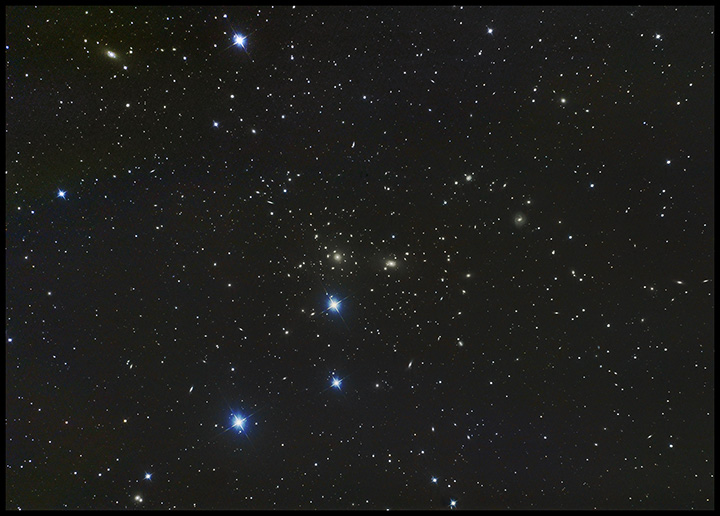The Realm of the Nebulae -2
The Coma Galaxy Cluster revisited, hardware notes
06/09/2016. As threatened here's the mulligan of the Coma Galaxy Cluster. Same data, different processing.There's a substantial difference at full size, mostly in the midrange and in noise; you can begin to see the difference by clicking between the image linked below and one linked from the previous page. At higher resolutions, the difference is even greater.

Click it. How can you see the galaxies if you won't click the pic (again)?
Also as threatened, I put PemPro to work refining the A-P Mach1's tracking. The manual that accompanied the mount said it should show less than 7 arcseconds of periodic error without PEC applied. I measured 5.3 arcseconds in a curve generated from 3 turns of the worm. Clearly, it's within specs. After invoking the factory PEC curve, the error was reduced, but not very much. I think it can do better.
I'm building a fresh curve with a Meade DSI-I Pro behind the Orion multi-purpose Guider (the FL is only 162mm) using Denebola for a target (0.1 sec exposures, every 2 seconds). Guide shows the image scale in RA to be 12.22 arc seconds per pixel, which might be OK but sounds inadequate. I took data through 5 rotations and generated a PE Curve showing the same error as before (which was encouraging), and then uploaded the new curve to the mount.
After three cycles: things are really not much better. +2.6/-2.0 arcseconds, 0.98 RMS, with a 1.8 arcsecond excursion peaking at 178-degrees of the cycle. It's a very slow drift, easily guided out. This could get obsessive. I'll re-measure and re-do all this with the AT65EDQ (FL = 442mm) or some longer focal length OTA soon.
"It's Always Somthing." I wanted to put the DSI behind the 10-inch F4 (FL = 1000mm) for PEC training, but the Newt's focuser fell apart (again) while I was racking it out (it would not have come close anyway). I'll fix the mechanicals tomorrow, or try to, but an aftermarket focuser is not out of the question. A Moonlite without fancy options and a universal mounting kit -- I could talk myself into that pretty easily. I'll need to measure to be sure I have the right options selected, and it calls for a night's sleep. [Take your time: one day on, the OEM focuser is either fixed or fixed enough.]
I tried PemPro's drift-align routine using the same guider. It worked well enough and will likely get easier with practice. PEMPRO said I ended up within six or seven arc minutes of the pole in both altitude and azimuth. If true, I'll recalibrate the A-P right-angle polar scope's adapter. It's a sparkling night, but I've got an eye appointment in the morning, and the OTA presently mounted, balanced, and instrumented is disabled until its focuser is fixed or replaced. That's a wrap.